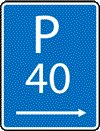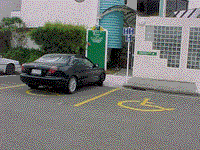16 Road Code Questions of Stopping and Parking
Note: If you wish to check whether you have master these questions, you may
proceed to
Take a Practice Test now with only questions from this Road Code topic.
If you do not have an account yet,
Sign Up one now, it is
FREE!
# 1. What does this sign mean?
 A. You may park your vehicle within the next 40 metres of the sign.B. You may park your vehicle for no longer than 40 minutes.C. You may park your vehicle for longer than 40 minutes if someone stays in it.D. You may not park your vehicle within the next 40 metres of the sign.
A. You may park your vehicle within the next 40 metres of the sign.B. You may park your vehicle for no longer than 40 minutes.C. You may park your vehicle for longer than 40 minutes if someone stays in it.D. You may not park your vehicle within the next 40 metres of the sign.
Explanation : The number shown under the P shows how many minutes you can park for.
# 2. Entrance ways into public car parks should be treated as:
A. turning bays.B. pedestrian crossings.C. intersections.D. merging lanes.
Explanation : Intersections include entrances and exits to and from supermarkets, petrol stations and other public parking areas such as airports and hospitals.
# 3. How close may you park your vehicle to an intersection where no broken yellow lines have been marked?
A. 3 metres.B. 4 metres.C. 5 metres.D. 6 metres.
Explanation : You must not park or stop your vehicle: on, or closer than six metres to, an intersection, unless there are parking spaces or a notice telling you that you can park there
# 4. When can you park your vehicle on the right-hand side of the road?
A. In a two-way street.B. In a one-way street where you may park on both sides of the road.C. Up to 1 metre from an intersection.D. If you are not parked over a fire plug.
Explanation : You must not park or stop your vehicle on the right-hand side of the road, except in a one-way street
# 5. You can stop or park your vehicle over a fire hydrant (fire plug) if:
A. a mobility card is displayed in the front window.B. it is not left unattended for less than 10 minutes.C. someone who can move it stays with the vehicle.D. your vehicle breaks down.
Explanation : You must not park or stop your vehicle: on, or closer than 50 centimetres to, a fire hydrant, unless somebody who can move the vehicle stays with it
# 6. How close can you park to an intersection where there are no broken yellow lines painted on the side of the road?
A. 3 metres.B. 4 metres.C. 5 metres.D. 6 metres.
Explanation : You must not park or stop your vehicle: on, or closer than six metres to, an intersection, unless there are parking spaces or a notice telling you that you can park there
# 7. What does this sign mean?
 A. Vehicles displaying a mobility card may park here.B. Any vehicles may park here.C. You can park your wheelchair here.D. Wheelchair parking space for the next 30 metres.
A. Vehicles displaying a mobility card may park here.B. Any vehicles may park here.C. You can park your wheelchair here.D. Wheelchair parking space for the next 30 metres.
Explanation : Only vehicles displaying a mobility parking permit can park here. you must display a mobility parking permit on your front window. Otherwise, you may be fined or have your vehicle towed away.
# 8. What is the meaning of a broken yellow line on the side of the road nearest the kerb?
A. Parking all hoursB. No stopping, you must not park or stop your vehicleC. Passenger drop offD. Parking for no longer than 5 minutes
Explanation : where a sign says that part of the road is reserved for specified kinds of vehicles (for example, bus, taxi or goods service vehicles) - in many cases, this restriction is marked by a broken yellow line more than 1 metre from the kerb
# 9. You may park your vehicle over a fire hydrant(fire plug) if you:
A. leave your keys in your vehicle.B. have someone stay with the vehicle who can move it.C. leave a note on the vehicle saying Back soon.D. will not be away from the vehicle for more than 5 minutes.
Explanation : You must not park or stop your vehicle on, or closer than 50 centimetres to, a fire hydrant, unless somebody who can move the vehicle stays with it
# 10. How close can you park your vehicle to the approach side of a pedestrian crossing where no broken yellow lines have been marked?
A. 6 metres.B. 5 metres.C. 4 metres.D. 3 metres.
Explanation : You must not park or stop your vehicle: on, or closer than six metres to, the approach side of a pedestrian crossing
# 11. What is the closest distance your vehicle may be parked to a vehicle entrance?
A. 0.5 metre.B. 0.75 metre.C. 1.00 metre.D. 1.25 metres.
Explanation : You must not park or stop your vehicle: in front of, or closer than one metre to, a vehicle entrance
# 12. You wish to move your vehicle out of a parking space into the traffic flow. What must you do before you move?
A. Flash your vehicle indicators for 1 second.B. Signal with your vehicle indicators for at least 3 seconds.C. Turn on your vehicle parking lights.D. Use your vehicle stop lights.
Explanation : You must signal for at least three seconds before you: move out:from a parking space; to pass another vehicle; to change lanes.
# 13. What should you do when parking your vehicle next to the kerb when facing down a steep hill?
A. Leave the front wheels of your vehicle straight ahead.B. Turn the front wheels of your vehicle towards the kerb.C. Turn the front wheels of your vehicle away from the kerb.D. Run the front and back wheels of your vehicle hard against the kerb.
Explanation : When parking downhill on a steep road: turn the front wheels towards the kerb; leave your car in reverse gear if it's manual or in park if it's automatic.
# 14. What must you do when parking uphill on a steep road?
A. Turn front wheels away from kerb and leave in 1st gearB. Turn front wheels toward kerb and leave in reverse gearC. Turn front wheels towards kerb and leave in 1st gearD. Leave in reverse gear with wheels facing front straight
Explanation : When parking uphill you must always turn the front wheels away from the kerb and put the car in 1st gear (if manual car) or park (if auto car)
# 15. You must NOT park on the right-hand side of the road except when you are:
A. in the countryside.B. picking up passengers.C. delivering packages.D. in a one-way street.
Explanation : You must not park or stop your vehicle on the right-hand side of the road, except in a one-way street
# 16. When parking downhill on a steep road, the Road code suggests that you should:
A. leave your keys in the vehicle in case the brakes fail.B. turn the front wheels of your vehicle away from the kerb and leave the vehicle in first gear.C. turn the front wheels of your vehicle towards the kerb and leave the vehicle in reverse gear.D. leave the wheels of your vehicle straight ahead and make sure that the handbrake is on.
Explanation : When parking downhill on a steep road: turn the front wheels towards the kerb, and leave your car in reverse gear if it's manual or in park if it's automatic.

